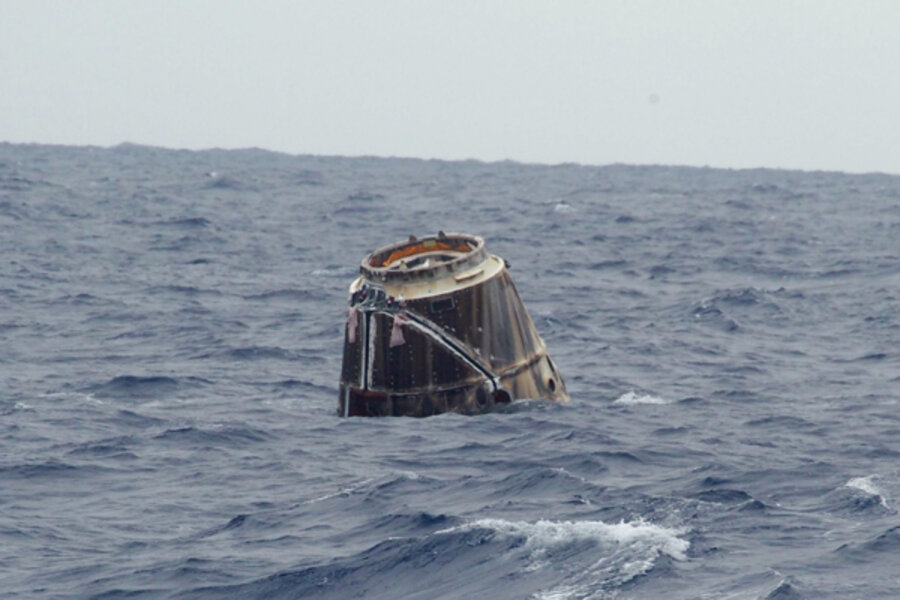SpaceX Dragon cargo ship splashes down in Pacific Ocean
Loading...
| Cape Canaveral, Florida
The SpaceX Dragon supply ship returned to Earth on Thursday, ending its revolutionary nine-day voyage to the International Space Station with an old-fashioned splashdown in the Pacific.
The unmanned capsule parachuted into the ocean about 500 miles off Mexico's Baja California, bringing back more than a half-ton of old station equipment. It was the first time since the space shuttles stopped flying last summer that NASA got back a big load from the orbiting lab.
Thursday's dramatic arrival of the world's first commercial cargo carrier capped a test mission that was virtually flawless, beginning with the May 22 launch aboard the SpaceX company's Falcon 9 rocket from Cape Canaveral and continuing through the space station docking three days later and the departure a scant six hours before it hit the water.
"Launch, docking, reentry and recovery successful," SpaceX's billionaire founder, Elon Musk, said in a statement provided by the company. "Welcome home, baby."
The returning bell-shaped Dragon resembled NASA's Mercury, Gemini and Apollo spacecraft of the 1960s and 1970s, yet symbolizes the future for American space travel. Musk aims to launch the next supply mission in September under a steady contract with NASA, and says astronauts can be riding Dragons to and from the space station in as little as three or four years.
Musk said in a tweet from the company's Mission Control in Hawthorne, Calif., that the next version of the capsule will land with "helicopter precision."
A fleet of boats was in position and quickly moved in to retrieve the bobbing Dragon.
The SpaceX Dragon represents NASA's future as laid out by President Barack Obama. He wants routine orbital flights turned over to private business so the space agency can work on getting astronauts to asteroids and Mars. Toward that effort, NASA has provided hundreds of millions of dollars in seed money to vying companies.
NASA astronauts are now forced to hitch rides on Russian rockets from Kazakhstan, an extremely expensive and embarrassing outsourcing, especially after a half-century of manned launches from U.S. soil. It will be up to SpaceX or another U.S. enterprise to pick up the reins; several companies are jockeying for first place.
NASA Administrator Charles Bolden offered up congratulations to SpaceX.
"This successful splashdown and the many other achievements of this mission herald a new era in U.S. commercial spaceflight," Bolden said in a statement.
As for the Dragon fresh from orbit, it will take a few days to transport it by barge to the Port of Los Angeles. From there, it will be trucked to the SpaceX rocket factory in McGregor, Texas, for unloading and inspection.
SpaceX plans to hustle off a few returning items while still at sea — mostly non-critical science samples — to demonstrate to NASA a fast 48-hour turnaround. That capability would be needed for future missions bearing vital experiments.
Space station astronaut Donald Pettit was eager to know the outcome. With 11 minutes remaining before splashdown, he asked NASA's Mission Control in Houston how things were going.
"Any chutes yet?" he wondered. Too early, came the reply. Four minutes later, grainy infrared TV images showed the three red-and-white-striped main parachutes all out, and Pettit was informed.
"That's good news," the astronaut said.
It took several minutes for SpaceX to pinpoint the splashdown spot because of clouds in the area that hampered NASA's tracking planes. Early reports were that the Dragon splashed down right on target.
The unmanned Dragon capsule returned nearly 1,400 pounds of old space station equipment and some science samples, a little more than it took up. Because it was a test flight, NASA did not want to load it with anything valuable. It carried up mostly food and clothing.
A Dragon returned from a short trip to orbit once before, on a solo shakedown cruise in December 2010.
Russia's Soyuz spacecraft for carrying crews also parachutes down, but on land, deep inside Kazakhstan. All of the government-provided cargo vessels of Russia, Europe and Japan are filled with station garbage and burn up on descent.
NASA lost the capability of getting things back when its shuttles were retired last July.
Rival Orbital Sciences Corp. hopes to have its first unmanned test flight off by year's end, launching from Wallops Island in Virginia. It also has a NASA contract for cargo runs.
Until American astronauts are flying again from U.S. soil, the focus will be on filling the space station's larder.
IN PICTURES: SpaceX Falcon and Dragon







